LEWISTON, Idaho--Once the most populous region of the northwest states, the Palouse is a fortunate corner of the globe, thanks primarily to its agriculture. From Walla Walla to Spokane, from Coeur d'Alene back down to Lewiston, the rolling hills of the Palouse grow the nation's richest crops of wheat and barley, lentils and chick peas.
Wheat grown on the Palouse yields up to 100 bushels an acre, twice the national average. Some 125 million bushels a year, worth $10 or so a bushel, harvested by lifelong farmers driving combines along the steeply contoured landscape with self-levelling, air-conditioned cabs (the world's most awesome riding mowers).
But crops are worth next to nothing unless they can find a market. And here's where the Palouse trumps the Midwest: by taking advantage of the deepwater channels of the Snake and Columbia Rivers. From an altitude of 700 feet above sea level here in Lewiston (the furthest-inland ocean-going port on the Pacific coast), giant barges (holding twice the payload of barges on the Mississippi) float the wheat 360 miles downriver, through a system of eight dams and locks (the Lower Granite, the Little Goose, the Lower Monumental, Ice Harbor, McNary, John Day, The Dalles and Bonneville), to Cargill's complex of grain elevators in Portland and Vancouver. Gargill and its longtime partner, Louis Dreyfus, anyway, who've just agreed to an amicable split. From Portland, it's another 100 miles downriver to the Pacific, then open water as far as China and Japan.
Ironically, this engine of private enterprise--wheat is worth a billion dollars a year in Washington, half that in Idaho--is driven by an agent of Big Government, the US Army Corps of Engineers, which has the responsibility to keep the channels dredged and the dams maintained.
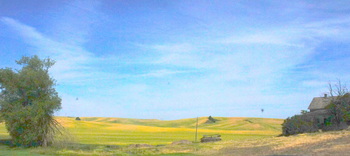 The bumper crop of Northwest wheat, "the best ever," according to agronomist Karl Umiker, who farms a 50-acre plot outside Lewiston, comes during a season of drought in the Midwest. According to an article last week in the Washington Post, "More than half of the continental United States is currently suffering through the worst drought in 50 years, with heat and a lack of rain rippling through the middle of the country. Crops are wilting, soils are cracked, and some dried-out forests are catching fire. U.S. corn production in particular is dwindling." Paul Krugman's column in today's New York Times focuses on the havoc wreaked by the hot weather in the heartland.
The bumper crop of Northwest wheat, "the best ever," according to agronomist Karl Umiker, who farms a 50-acre plot outside Lewiston, comes during a season of drought in the Midwest. According to an article last week in the Washington Post, "More than half of the continental United States is currently suffering through the worst drought in 50 years, with heat and a lack of rain rippling through the middle of the country. Crops are wilting, soils are cracked, and some dried-out forests are catching fire. U.S. corn production in particular is dwindling." Paul Krugman's column in today's New York Times focuses on the havoc wreaked by the hot weather in the heartland.
It's been hot on the Palouse, too, but there were some late spring rains. Even in late July, the patchwork of colors still retain some pastel green fields among the golden stalks ready for harvest.
Where will all this grain go? The vast majority, low-gluten, low-protein, soft white wheat, heads to Asia, where it gets milled and converted into noodles and dumplings. (American mills prefer wheat grown in Montana and the Dakotas, with higher gluten content, for baked goods like bread.) But some of the Palouse's wheat stays close to home, finding its way into the products of an innovative regional food cooperative.
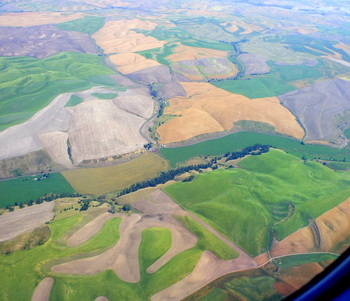 Flying from Seattle to Pullman as the guest of the North Central Idaho Travel Association (for a series of articles about a new, bi-state American Viticultural Area called Lewis-Clark Valley) I was struck by the topography of the Palouse as harvest approached in late July. Waves of color: green and gold wheat, lentils, peas, bluebunch, yellow mustard and rapeseed, Idaho fescue, all so carefully tended that It was hard to tell where the croplands ended and the golf course fairways began. Up here on the plateau, shopping centers and strip malls nibble at the edges of the wheat fields.
Flying from Seattle to Pullman as the guest of the North Central Idaho Travel Association (for a series of articles about a new, bi-state American Viticultural Area called Lewis-Clark Valley) I was struck by the topography of the Palouse as harvest approached in late July. Waves of color: green and gold wheat, lentils, peas, bluebunch, yellow mustard and rapeseed, Idaho fescue, all so carefully tended that It was hard to tell where the croplands ended and the golf course fairways began. Up here on the plateau, shopping centers and strip malls nibble at the edges of the wheat fields.
Washington State University in Pullman and the University of Idaho in Moscow are twin landgrant institutions located just five miles apart. WSU has added a high-tech incubator in a business park adjacent to its campus. It's the headquarters of Schweitzer Electrric Labs, started 30 years ago by a WSU grad, a supplier of advanced equipment to the power industry; it provides thousands of local jobs. In the same complex is Merry Winery, operated by a computer Ph.D. turned enologist, Patrick Merry, who supervises WSU's student winemaking programs.
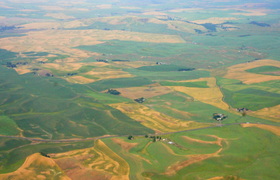 Back to the wheat. It may not have the cachet of cabernet sauvignon, but wheat from the Palouse is too valuable to graze the beasts of Wazzu's Large Animal program. In fact, with yields of 100 bushels (at 60 pounds per bushel), the production is three tons per acre, worth up to $1,000.
Back to the wheat. It may not have the cachet of cabernet sauvignon, but wheat from the Palouse is too valuable to graze the beasts of Wazzu's Large Animal program. In fact, with yields of 100 bushels (at 60 pounds per bushel), the production is three tons per acre, worth up to $1,000.
Just to compare: an acre of wine grapes produces between two and five tons, worth up to $10,000 in Washington. Wine grapes require irrigation and constant care, but the payoff explains why so many wheat, carrot and potato farmers have also planted vineyards.
One problem with farming commodity crops, however valuable, is that the producer is at the mercy of market forces. That, and he never gets to know his customers. So Palouse farmers Karl Kupers and Fred Fleming co-founded a thriving cooperative called Shepherd's Grain that does something virtually unthinkable: they not only market their own wheat, they demand that coop members (35 families at this writing) change their farming practices to a more environmentally friendly model known as no-till direct seeding to avoid erosion on the steep slopes of the Palouse.
Just as important is the closer relationship that the farmers have with their customers. Bakers learn more about the way the flour is produced; farmers see how their product is used.
Says Kupers, "Our farmers use no-till cultivation methods, which plant a crop directly in the stubble of the previous season's crop rather than till the field first."
Growing grain for local markets, Fleming said, also puts control of pricing in the hands of the farmers rather than distant commodity brokers or Wall Street speculators.
"Karl and I both thought that we needed to be that price-setter rather than a price-taker and de-commodify our product," Fleming said. To that end, milling is done close to the Palouse, in Spokane. The miller, ADM (Archer Daniels Midland), is a global behemoth, but its Spokane milling team recognizes the value of sustainably produced wheat and treats Shepherd's Grain with unusual care.
For their part, bakeries can identify the grower of each bag of Shepherd's Grain flour using a code on the bag, and can print out a color poster of the family that grew the wheat. Now, that's a connection you can't get with Gold Medal or Pillsbury.
From the rim of the canyon, a view of the confluence of the Clearwater River, arriving from left, and the Snake River, arriving from the top, above the twin cities of Lewiston, Idaho, left, and Clarkston, Wash. The Lewiston Orchards plateau can be seen in the center of the photo. Lewiston is at the lower center of the map, with Pullman and Moscow near the top. The crop land is called the Palouse, perhaps because the local Indian tribe was known as the Palus.
This article originally appeared, in slightly different form, on Crosscut.
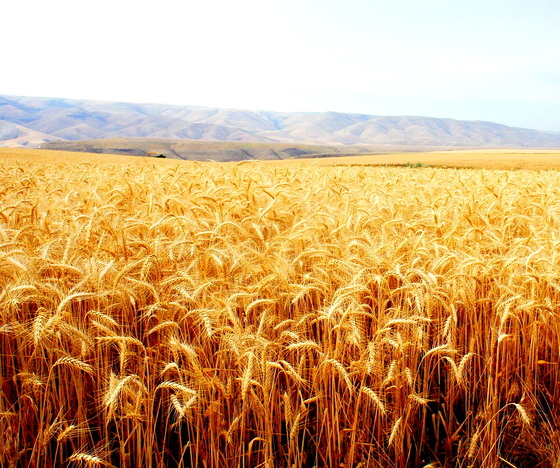
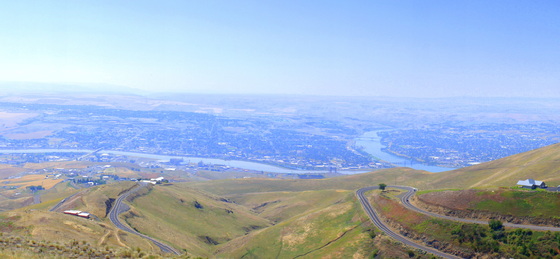
Leave a comment